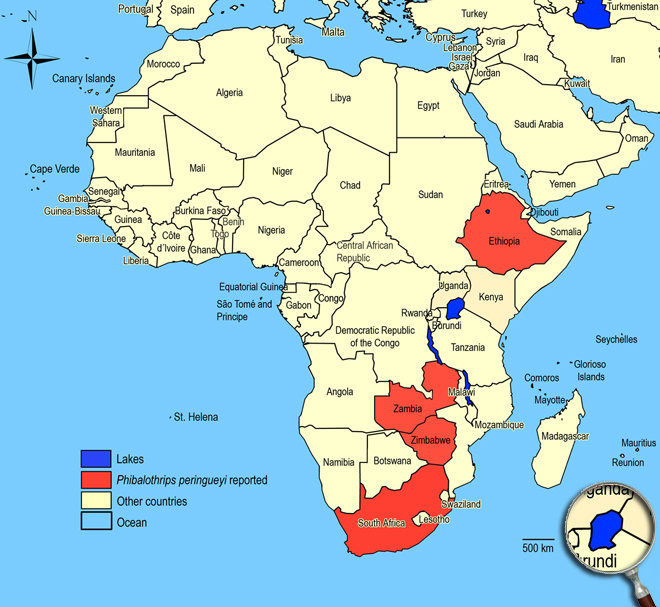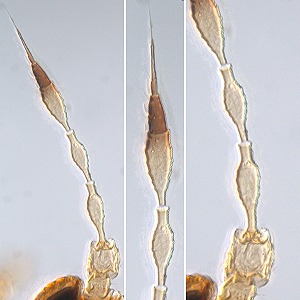Phibalothrips peringueyi (Faure, 1925)
Panchaetothripinae, Thripidae, Terebrantia, Thysanoptera
Figures
Fig. 1: 7-segmented antenna, terminal segments IV-VII, pedicel and segments III and IV
Fig. 2: Head dorsal with ocellar triangle, pronotum and antennae
Fig. 3: Head and pronotum
Fig. 4: Head and left fore leg
Fig. 5: Meso- and metanotum
Fig. 6: Head, pronotum and pterothorax
Fig. 7: Fore- and hind wing, fore wing distal region
Fig. 8: Tergites II-IV
Fig. 9: Tergites IV-VI
Fig. 10: Sternites IV-VI with glandular pore plates (male)
Fig. 11: Tergites VIII-XI
Introduction and recognition
Phibalothrips peringueyi damages leaves of various grasses (Poaceae). Both sexes fully winged. Body bicolored; head, pro- and mesothorax and metascutal triangle dark brown; rest of body, legs and antennal segments I-V yellow; antennal segments VI & VII entirely brown; fore wings pale with veins yellow. Antennae 7-segmented; segment II barrel-shaped and with recurved base, III with flange around basal pedicel, III & IV elongate with simple sense cone; V-VII forming a single unit (Fig. 1). Head quadrate, with large independent reticles; cheeks parallel sided constricted at base; vertex with deep grooves around large eyes; ocelli on raised area (Fig. 2). Pronotum transverse, lateral margins expanded; with 2 transverse bands of reticulation; no long setae (Fig. 3). Mesonotum not divided longitudinally. Metascutal dominant sculptured triangle slender and reticulate; median setae small (Fig. 5). Mid and hind tarsi 1-segmented (Fig. 4). Fore wing slender, parallel sided, apex blunt with pair of long cilia; fore wing first vein close to or fused to costal vein; costa without cilia, veinal setae minute; posterior cilia scarcely undulating (Fig. 7). Tergites lateral thirds with polygonal reticulation, many markings within the reticles and a tooth-like comb posteromarginally; tergites medially smooth and with a longitudinally raised ridge; median pair of tergal setae minute (Fig. 8 and 9); X with complete longitudinal division (Fig. 11). Sternal marginal setae minute.
Male similar to female but smaller; tergite IX with a pair of long strong setae; sternites III-VII each with a small oval glandular area near anterior margin (Fig. 10).
Taxonomic identity
Species
Phibalothrips peringueyi (Faure, 1925)
Taxonomic history
Phibalothrips basis Chen, 1981
Reticulothrips peringueyi Faure, 1925
Common name
-
Present taxonomic position
Family: Thripidae Stephens, 1829
Subfamily: Panchaetothripinae Bagnall, 1912
Genus: Phibalothrips Hood, 1918
Genus description
The genus Phibalothrips Hood, 1918
4 species are described in this genus. Phibalothrips rugosus from Malaysia, Phibalothrips peringueyi from South Africa and India (Wilson 1975), Phibalothrips longiceps from countries further east and Phibalothrips dispar from Macaronesian Islands (zur Strassen 1974). This genus of grass-living Panchaetothripinae species have a small, slender bicolorous body with reticulated sculpture, 7-segmented antennae with simple sense cone on segments III & IV and segments V-VII forming a single unit. All of them have long, slender, parallel sided fore wings lacking fringe cilia on the anterior margin and long setae (Wilson 1975).
Species description
Typical key character states of Phibalothrips peringueyi
Coloration and body sculpture
Body color: distinctively bicolored
Surface of head, pronotum and fore legs: with heavy, often polygonally reticulate sculpture
Sculptured reticles on head and pronotum: with no internal markings
Antennae
Form of sense cones on antennal segments III and IV: emergent and simple on segments III and IV
Number of antennal segments: 7
Terminal antennal segments: V-VII forming a single unit
Head
Cheeks shape: constricted to basal neck
Head - occipital ridge dorsally: absent
Ocelli: present
Prothorax
Pronotal blotch or internal apodeme: absent
Pronotum shape: broadly rectangular
Mesothorax
Mesonotum: with an incomplete median division
Metathorax
Metanotum with dominant sculptured triangle medially: with dominant sculptured triangle medially
Shape of metathoracic furca: transverse, V-shaped
Wings
Fore and hind wings: present, more than half as long as abdomen (macropterous)
Fringe cilia arising: from sockets
Fore wing veins: present
Fore- and hind wing surface: covered with microtrichia
Apex of fore wing: with prominent terminal setae
Fore wing anterior margin (costal vein): without any long setae or long cilia
Fore wing costal fringe cilia: arising at anterior margin of wing
Fore wing first vein: close to or fused to costal vein
Fore wing first vein setal row: incomplete, with setae not closely and uniformly spaced
Fore wing second vein setal row: incomplete, with setae not closely and uniformly spaced
Fore wing shape: mainly parallel sided or margins run continuously towards each other
Fore wing surface: not reticulate
Fringe cilia on posterior margin near apex: straight
Length of fore wing costal setae at middle of wing: minute
Shape of fore wing apex: with mainly posterior margin curved to join anterior margin
Fore wings: pale with dark area(s) or uniformly pale or weakly shade
Fore wing extreme apex color: dark (pale misinterpreted)
Legs
Mid and hind tarsi: with one segment
Colour of fore tarsi: pale or yellow, sometimes apical shaded or brown
Abdomen
Tergite II: without specialised cuticles laterally
Tergites IV and V median setal pair: shorter than distance between their bases
Tergite VIII to X: without unusually long and stout setae
Tergites: with distinctive tergal sculpture forming a series of hair clamp-like arches on the antecostal ridges
Tergite X: not tubular, longitudinally incomplete
Setae on abdominal tergite X: all setae slender

Similar or related species
Phibalothrips is a member of the Heliothrips group, and Phibalothrips peringueyi is similar to Retithrips syriacus and Rhipiphorothrips miemsae. With all of them it agrees in having minute costal setae and mostly no cilia on anterior margin of fore wings, straight cilia on posterior margin of fore wings, uniformly pale or light brown fore wings, and a dominant or weakly sculptured triangle medially on metanotum. But only Phibalothrips peringueyi has a distinctive tergal sculpture forming a series of hair clamp-like arches on the antecostal ridges. Unlike Phibalothrips peringueyi, Rhipiphorothrips miemsae and Retithrips syriacus have 8-segmented antennae with forked sense cone on segments III & IV, whereas Phibalothrips peringueyi has 7-segmented antennae with simple sense cone on segments III & IV. Only Rhipiphorothrips miemsae bears a strong irregular reticulate and rugose sculpture on the head, in contrast to other species with polygonal reticles on the head (Retithrips syriacus with distinct internal wrinkles; Phibalothrips peringueyi without internal wrinkles), and has a complete longitudinal division medially on mesonotum (other species with incomplete median division). Compared to the other species, the fore wings of Retithrips syriacus bearing anteromarginally 3 curious blister-like callosities. Furthermore only in Retithrips syriacus the metathoracic furca is elongate and Y-shaped, and tergite VIII has a complete comb of long strong microtrichia (in contrast to Rhipiphorothrips miemsae and Phibalothrips peringueyi with posteromarginal comb of microtrichia absent or only laterally present).
Biology
Life history
As with other thrips species the life cycle from egg to adult is dependent on temperature. The full cycle can take about 15 days to over a month and adults may live for more than one month producing several generations in one year depending on seasonal weather (Lewis 1973). With greenhouse temperatures the developmental time from egg to adult can decrease to about one week.
Host plants
Grasses, maize (Poaceae).
Vector capacity
None identified, but possible mechanical distribution of phytopathogenic fungi and bacteria.
Damage and symptoms
-
Detection and control strategies
-
Additional notes
-
Biogeography
Central India, Taiwan, southern Africa. Ethiopia, South Africa (Limpopo: Woodbush; Gauteng: Pretoria), Zambia, Zimbabwe.
African countries where Phibalothrips peringueyi has been reported

The species Phibalothrips peringueyi was not observed in surveys undertaken in East Africa on vegetables and associated weeds and crops.
Please click here for survey sites of all observed thrips species of Kenya, Tanzania and Uganda.

Bibliography
Chen L-S (1981). Studies on the Panchaetothripinae (Thysanoptera: Thripidae) in Taiwan. Plant Protection Bulletin, Taiwan. 23: 117-130
Faure JC (1925). A new genus and five new species of South African Thysanoptera. South African Journal of Natural History. 5: 143-166
Kudo I (1992). Panchaetothripinae in Japan (Thysanoptera, Thripidae), 1. Panchaetothripini, the genera other than Helionothrips. Japanese Journal of Entomology. 60 (1): 109-125
Lewis T (1973). Thrips: their biology, ecology and economic importance. Academic Press Inc., London Ltd., 349 pp
Wilson TH (1975). A monograph of the subfamily Panchaetothripinae (Thysanoptera: Thripidae). Memoirs of the American Entomological Institute. 23: 1-354
zur Strassen R (1960). Catalogue of the known species of South African Thysanoptera. Journal of the Entomological Society of Southern Africa. 23 (2): 321-367
zur Strassen R (1974). Neue silvicole Fransenflügler von den makaronesischen Inseln (Ins.: Thysanoptera). Senckenbergiana biologica. 55: 105-134
zur Strassen R (2003). Die terebranten Thysanopteren Europas und des Mittelmeer-Gebietes. Die Tierwelt Deutschlands und der angrenzenden Meeresteile nach ihren Merkmalen und nach ihrer Lebensweise, 74. Teil. Goecke & Evers, Keltern, Germany, 277 pp
----
Web links
Mound´s Thysanoptera pages
Thysanoptera Checklist
ICIPE Thrips survey sites
UNI Halle & Thrips sites
Thrips of California














